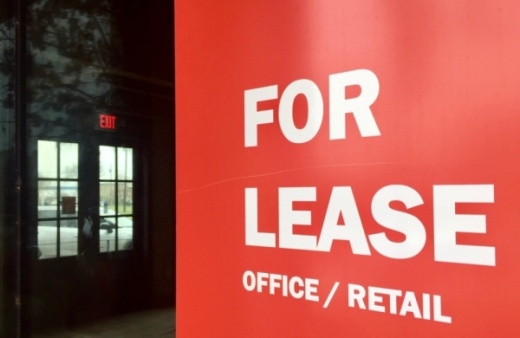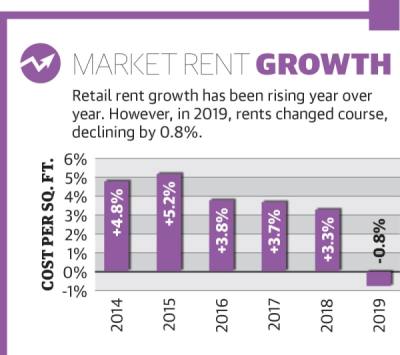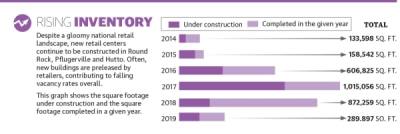“In this market, retail has been incredibly healthy, compared to the dour national headlines that say retail is dead,” said Sam Tenenbaum, the director of analytics for the CoStar Group.
But as wave after wave of national retailers close, the booming local market is beginning to absorb a few blows. Following years of catapulting rent increases, in 2019, the base asking rent in Round Rock, Pflugerville and Hutto decreased, an indication that local retail real estate is beginning to let off the accelerator.
“People are still going to retail stores locally, but this kind of slowed down [in 2019],” Tenenbaum said. “Among other factors, national store closures started affecting what landlords thought they could price things at.”
Vacancies
The CVS on the corner of Wells Branch Parkway and Dessau Road in Pflugerville closed Jan. 9. The location is one of approximately 75 that the pharmacy company plans to close this year, following 45 store closures in 2019.
CVS joins Rue21, Charming Charlie, Payless ShoeSource, Charlotte Russe, Gymboree and a litany of other national companies declaring bankruptcy, consolidating and shuttering stores.
But closures alone do not paint a full picture of the health of a retail center, Tenenbaum said.
“Churn is healthy and expected within the real estate market,” he said. “That’s a factor of life. Not every retailer can make it and be successful.”
Josh Frielander, a broker with NewQuest properties, leases retail space in Pflugerville’s Stone Hill Town Center. Frielander said he has a long list of tenants who are eager to occupy space in the shopping center.
Clothing store Rue21 closed its Stone Hill location on Nov. 11. By Dec. 9, signage was installed on the building indicating Bath and Body Works was coming soon.
“Bath and Body Works has wanted to be in Stone Hill for years,” Frielander said. “And they’re just now getting an opportunity. That just shows how hot this shopping center is.”
As it stands, around 11,000 square feet out of close to 1 million—or just over 1%—is available to lease in Stone Hill, Frielander said.
“In reality, there are retailers that are struggling and closing, but what we’ve found locally is that for every one that closes, typically another one is ready to move in and fill the vacancy,” he said.
Bealls, a chain department store, closed its Stone Hill location Jan. 18. Frielander said the shopping center is already inking a deal with an interested tenant to fill the space.
In general, across the Austin-Round Rock metropolitan area, retail centers remain well-occupied at or above 95% occupancy, Tenenbaum said. In 2019, the occupancy rate across retail centers in Round Rock, Pflugerville and Hutto was 95.3%.
However, occupancy rates are not the only measure experts use to gauge the health of area retail.
“I look more at the rent growth than at the occupancy,” Tenenbaum said. “Occupancy doesn’t really tell you sentiment—who might be about to move out—as much as rent growth does.”
Rent fluctuations
Across Round Rock, Pflugerville and Hutto, asking rent dropped by $0.20 per square foot—or about 0.8%—in 2019, according to CoStar data. This is a sharp break from consistent year-over-year rises in asking rent.
“Generally speaking, we’ve seen rent fall in this market over the past year in retail,” Tenenbaum said. “And that’s mostly attributed to yet another wave of store closures nationally that are happening everywhere, and nobody’s feeling particularly great about owning or running a retail store.”
This change suggests a shift of pricing power back to the tenants, Tenenbaum said.
“A tenant can now say, ‘How can you justify increasing my rent? I just saw 15 other retailers go out of business here,’” he said. “It gives tenants another leg to stand on for negotiations with their landlord.”
But a drop in asking rent does not mean a tenant’s payments are less. Most area rents are a combination of a base rent and triple-net fees—costs that consist of a portion of the center’s real estate taxes, building insurance and maintenance.
Esther and Hai Lue Lim, owners of local Chinese restaurant Great Wall Express, said they closed two of their three locations in 2019 due to overall rising rent payments and difficulty staffing multiple locations. Their son, Justin Lim, said the triple-net fees were rising quickly at the Pflugerville location, where they had been serving food for 17 years.
“Our payments were getting higher,” Justin Lim said. “I know the landlords in their shopping centers, their taxes have been going up a lot, and it was passed on in our triple-net [fees].”
As area property values increase so, too, do real estate taxes. This results in rising costs overall for tenants, like the Lims, even if the base asking rent is less.
New construction
While certain area retail centers are thriving, other older centers are sitting largely vacant.
“Some of our retail centers aren’t new and fresh anymore,” Round Rock Council Member Matt Baker said during a Jan. 16 work session.
Round Rock City Council discussed unattractive commercial centers, changing retail patterns and vacant retail space, among other challenges facing the city in 2020.
“We know big-box stores are declining,” Baker said. “The question is what to do with those spaces?”
As some aging facilities sit vacant, new construction continues in other parts of the market—though not at the feverish pace building new retail centers once occurred. Across Round Rock, Pflugerville and Hutto, more than 1.6 million square feet of new retail space was added from 2014-19.
Coming out of the 2008 recession, Tenenbaum said, construction of new retail is much slower across the country than it once was.
“If this were 2006 or 2007, we would have seen double—maybe more—the construction than we’re seeing,” he said.
Lenders have been restrained in giving loans, particularly for speculative retail space, he said. Now, most new inventory is built with tenants committed.
“We’re building far less retail than we have been,” Tenenbaum said. “When we do build, it’s typically well-leased. And that’s why as we build the new space, the vacancies continue to go down.”
Future of retail
The face of retail is changing. With the rise of e-commerce—the selling of products online—and home delivery services, major retail centers now focus on attracting service-based tenants: restaurants, fitness studios, beauty salons, medical providers and entertainment.
At University Oaks Shopping Center in Round Rock, an outdoor play space adjacent to several restaurants provides a draw for families, said Ivy Z. Greaner, executive vice president and chief operating officer of the InvenTrust Properties Corp. InvenTrust acquired the University Oaks Shopping Center in 2009.
“This has been a very stable center, with high occupancy throughout the last five years,” Greaner said in an email to Community Impact Newspaper. “The location and tenancy is solid and serves the population well.”
As it stands, University Oaks is 85% leased, Greaner said. A larger box vacancy, which is under negotiation now, will bring the shopping center to 95% occupancy, she said.
“Retail has continually changed shape throughout the years,” Greaner said. “Well-positioned real estate, as well as forward-thinking landlords, have always been able to adjust to the marketplace changes to continue to meet the needs of the community and help drive sales for their tenant constituents.”
Frielander said location in an area with high population growth is key to future success.
“Stone Hill is a pretty stable asset right now, and I don’t foresee much changing in the future,” Frielander said. “It’s such a dominant center. I just expect that in five years, everyone will be doing even better. I think it’ll continue to be a very strong center with very low vacancies.”










